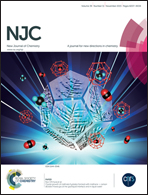Polyacrylamide modified mesoporous SBA-16 hybrids encapsulated with a lanthanide (Eu3+/Tb3+) complex
Abstract
Novel luminescent polymer-functionalized mesoporous SBA-16 type hybrid materials with encapsulated lanthanide (Eu3+ and Tb3+) complexes for luminescence have been synthesized in situ. The organic molecule acrylamide (AM) was first modified by a silane coupling agent 3-(triethoxysilyl)propylisocyanate (TEPIC) to form an alkene precursor, which was then covalently bonded to a mesoporous SBA-16 backbone through co-hydrolysis and co-condensation reactions. Then, the flexible polymer chain polyacrylamide (PAM) within the pores of SBA-16 could be formed by initiating the monomer. Through introducing the lanthanide ions and the typical ligand 1,10-phenanthroline (phen), the luminescent mesoporous hybrids (denoted as Ln(S16-PAM-Si)3 and Ln(S16-PAM-Si)3phen, respectively) with the organic polymer acting as a flexible linker between the mesoporous framework and the lanthanide complex were finally attained. The results reveal that these materials exhibit high surface area, uniform mesostructure and efficient intramolecular energy transfer. Moreover, the ternary hybrids present higher red/orange ratio, stronger luminescent intensity, longer lifetime and higher 5D0 luminescence quantum efficiency than the binary one, suggesting that the luminescent properties have been significantly improved with the introduction of the organic ligand phen.


 Please wait while we load your content...
Please wait while we load your content...